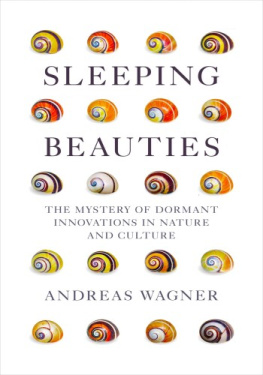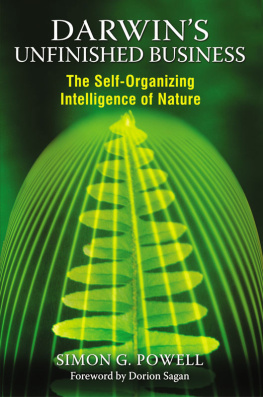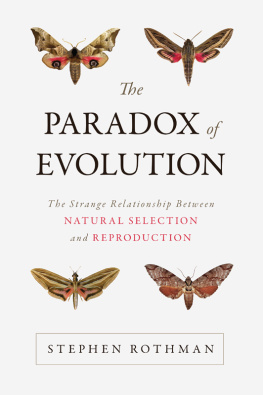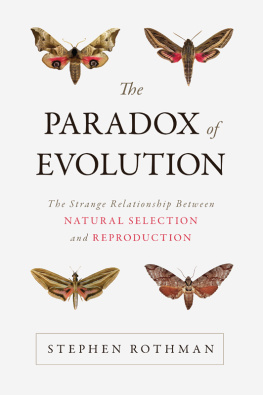USA | Canada | UK | Ireland | Australia | New Zealand | India | South Africa | China
Penguin supports copyright. Copyright fuels creativity, encourages diverse voices, promotes free speech, and creates a vibrant culture. Thank you for buying an authorized edition of this book and for complying with copyright laws by not reproducing, scanning, or distributing any part of it in any form without permission. You are supporting writers and allowing Penguin to continue to publish books for every reader.
Arrival of the fittest : solving evolutions greatest puzzle / Andreas Wagner.
Includes bibliographical references and index.
1. Natural selection. 2. Evolutionary genetics. I. Title.
While the author has made every effort to provide accurate telephone numbers and Internet addresses at the time of publication, neither the author nor the publisher is responsible for errors, or for changes that occur after publication. Further, the publisher does not have any control over and does not assume any responsibility for author or third-party websites or their content.
PROLOGUE
World Enough, and Time
I n the spring of 1904, Ernest Rutherford, a thirty-two-year-old New Zealandborn physicist then working at McGill University in Canada, gave a lecture at the worlds oldest scientific organization, the Royal Society of London for Improving Natural Knowledge. His subject was radioactivity and the age of the earth.
At that time, scientists had long since forsworn the biblical accounts asserting that the earth was only six thousand years old. The most widely accepted dates had been calculated by another physicistWilliam Thomson, better known as Lord Kelvinwho had used the equations of thermodynamics and the earths heat conductivity to estimate that the planet was somewhere around twenty million years old.
In geology, thats not a lot of time, and the implications were profound. The earths geological features could not have appeared within this duration if processes like volcanism and erosion proceeded at todays rate. Twenty million years was not enough time to create lifes diversity.
But Rutherford, who had discovered the phenomenon of radioactive half-life only a few years before, knew that Kelvin was wrong, by at least several orders of magnitude. As he later recalled:
I came into the room, which was half dark, and presently spotted Lord Kelvin in the audience and realized that I was in for trouble at the last part of the speech dealing with the age of the earth, where my views conflicted with his.... The discovery of the radio-active elements, which in their disintegration liberate enormous amounts of energy, thus increases the possible limit of the duration of life on this planet, and allowsthe time claimed by the geologist and biologist for the process of evolution. (emphasis added).
And that was that. Kelvin died in 1907. Rutherford won the Nobel Prize in 1908, and by the 1930s his radiometric methods had shown that the earth was around 4.5 billion years old. Darwins theory was saved, since the processes of random mutation and selection now had the time needed to create lifes enormous complexity and diversity.
Or did they?
Consider the peregrine falcon, Falco peregrinus, one of natures great predators and an organism of marvelous perfection. Its powerful musculature, matched with an extremely lightweight skeleton, makes it by far the fastest animal on earth, able to reach more than 200 miles per hour in one of its characteristic dives. All that speed translates into enormous kinetic energy when the falcon strikes its prey in midair with razor-sharp talons. If that impact alone does not deliver death, the falcon can sever the spinal column of its prey with a conveniently notched upper beak.
Before moving in for the kill, F. peregrinus needs to track down its prey. The targeting mechanism is a pair of eyes with full-color binocular vision, possessing resolving power more than five times greater than a humans, which means that a peregrine can see a pigeon at distances of more than a mile. Like many predators, the falcon has an eye with a nictitating membranea third eyelida bit like a windshield wiper that removes dirt while keeping the eye moist during a high-speed chase. The falcons eyes also harbor more photoreceptors, the rods that capture images in very low light, and the cones that provide color vision. Its photoreceptors render even long-wavelength ultraviolet light visible.
A marvel indeed. But even more marvelous is knowing that every one of those brilliant adaptations is the sum of innumerable tiny steps, each one preserved by natural selection, each one a change in a single molecule. The deadly beak and talons of F. peregrinus are built from the same raw material as its feathers, the protein molecules known as keratin, the human versions of which make up your hair and nails.
The first vertebrates to use crystallins in lenses did so more than five hundred million years ago, and the opsins that enable the falcons vision are some seven hundred million years old. In fact, its countless billions of times less likely. If a trillion different organisms had tried an amino acid string every second since life began, they might have tried a tiny fraction of the 10 potential ones. They would never have found the one opsin string. There are a lot of different ways to arrange molecules. And not nearly enough time.
When the seventeenth-century lyric poet Andrew Marvell bemoaned, Had we but world enough, and time to avoid the deserts of vast eternity that lay before him, he was attempting to unlock his mistresss bedchamber, not the secrets of nature. But he was on to something. Common wisdom holds that natural selection, combined with the magic wand of random change, will produce the falcons eye in good time. This is the mainstream perspective on Darwinian evolution: A tiny fraction of small and random heritable changes confers a reproductive advantage to the organisms that win this genetic lottery and, accumulating over time, such changes explain the falcons eyeand, by extension, everything from the falcon itself to all of lifes diversity.
The power of natural selection is beyond dispute, but this power has limits. Natural selection can preserve innovations, but it cannot create them. And calling the change that creates them random is just another way of admitting our ignorance about it. Natures many innovationssome uncannily perfectcall for natural principles that accelerate lifes ability to innovate, its innovability.
For the d last fifteen years, I have been privileged to help uncover these principles, first in the United States and later, joined by a group of highly talented researchers, in my laboratory at the University of Zrich in Switzerland. Using experimental and computational technologies unimagined by Darwin or Rutherford, our goal is not to discover individual innovations, but to find the wellsprings of









